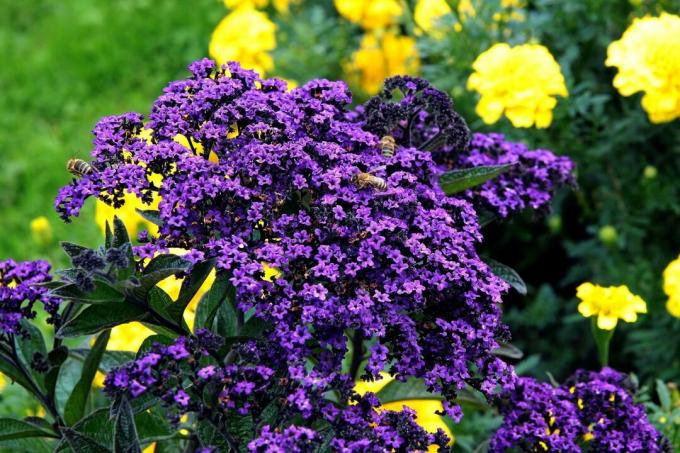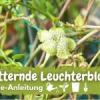The vanilla flower, also called solstice or heliotrope, is a wonderfully fragrant eye-catcher for every garden or balcony. We introduce you to the most beautiful solstice species and show you how to properly plant and care for the South American beauty.

contents
- Vanilla flower: flowering time, origin and properties
- The most beautiful solstice varieties
-
Plant heliotropes
- The perfect location for solstices
- What do you have to consider when planting solstices in the bed?
- Vanilla flowers for the balcony: tips for planting in pots
-
Caring for vanilla flowers
- watering solstices
- fertilize solstices
- Cut vanilla flowers
- Vanilla flowers overwinter
- increase solstices
- Is the vanilla flower poisonous?
- Is vanilla flower bee friendly?
Vanilla flower: flowering time, origin and properties
The vanilla flower (Heliotropium arborescens) belongs to the borage family or borage family and has its origins in the Peruvian Andes. The flowering period of the vanilla flower is wonderfully long, up to five months, from May to September. The sun-loving vanilla flowers show an upright, dense growth and reach heights of 30 to 80 centimeters depending on the variety. Many small, five-petalled, mostly dark violet individual flowers form luxuriant umbels above elliptical, alternate, mostly dark green leaves. The leaves are wrinkled and slightly hairy. The vanilla flower is also known as the solstice because its leaves - like many species of the genus
heliotropium – Always align to the sun and rotate with the position of the sun. Another special feature of the vanilla flower, as the name suggests, is its intense vanilla scent.The most beautiful solstice varieties
There are several varieties of the vanilla flower, which differ in the color of the flowers, the color of the leaves, the height of the plant and the smell of the flowers.
Here is a selection of the most beautiful Solstice varieties:
- 'Alba': White flowers with a very intense vanilla scent
- ′Marine': Dark violet to deep blue flowers; stocky growth: 30 – 40 cm
- ′Ahrensburg Castle′: medium blue flowers; blooms very early; smallest variety: 30 cm
- 'Iowa': Light purple flowers; Scent of gummy bears
- 'Aurea': Light purple flowers; green-yellow foliage

Plant heliotropes
Heliotropes can be planted in pots on the terrace or balcony as well as in beds - the main thing is that the location offers plenty of sun!
The perfect location for solstices
Solstices love the sun and should therefore of course be planted in a sunny spot. Even partially shaded locations are suitable, but the optimal development of the plant is achieved in direct sunlight. The perfect location is also protected as well as possible from wind and rain.
What do you have to consider when planting solstices in the bed?
If you have found a sun-exposed place in your bed, it is also important that the soil around the vanilla flower is humus, fresh and permeable to water. In order for the plant to develop optimally even on slightly poorer soil, you can use some good potting soil such as the Plantura organic potting soil put in the planting hole. Before inserting, pull apart the root ball of the vanilla flower to stimulate root formation. Also, be careful not to plant the vanilla flower too deep. Immediately after planting, the vanilla flower is happy about plenty of water.
Vanilla flowers for the balcony: tips for planting in pots
Vanilla flowers also thrive in pots on the balcony or patio. When planting, choose a sufficiently large planter so that the roots can develop well. In order to avoid waterlogging, there must be a drainage hole in the bottom of the container. So that this remains free, potsherds can be placed over it. Our peat-free Plantura is suitable as a substrate organic potting soil very good. It offers the perfect conditions for strong growth and lush flowers during the solstices. The expanded clay it contains ensures balanced moisture and thus healthy root growth.
Caring for vanilla flowers
In addition to its claim to location, which you can easily recognize from the name, the Solstice is relatively robust and easy to care for. Nevertheless, care must be taken to ensure the correct supply of water and nutrients.
watering solstices
The solstices should be watered daily. However, since the vanilla flower is sensitive to waterlogging, excess water must be allowed to drain away or seep away.
fertilize solstices
In order to cover the nutrient requirements of the solstices, a monthly application of liquid fertilizer is recommended from April to September. Our purely organic Plantura organic flower & balcony fertilizer provides the fragrant vanilla flowers with all the important nutrients quickly and easily.
Cut vanilla flowers
The dried blossoms and parts of the plant should be cut off so that the vanilla flower keeps investing its energy in the formation of new, magnificent inflorescences. In the case of young plants that have been brought forward, it is also advisable to regularly pinch off the shoot tips. This stimulates tillering, making the plants bushier and not growing too tall. If necessary, you can cut back slightly in autumn before wintering.
Vanilla flowers overwinter
Vanilla flowers are not hardy and do not tolerate temperatures below 5 °C. That doesn't mean you have to discard the plants once they've bloomed, though, because if solstices are overwintered in a sheltered spot, they'll bloom again in full bloom the following year. With the right care, the vanilla flower gets bigger and stronger from year to year. In autumn, before the first frosts, place the heliotrope in a wind-protected, dry and bright place. The temperature should be between 12 and 18 °C. The plant only needs to be watered a little during the winter months, fertilization is not required at all. In May, when the nights are frost-free, you can put the vanilla flower back on your balcony or in the garden.

increase solstices
On the one hand, the vanilla flower can be propagated by seeds. Sow from January to March in a bright, 18 to 22 °C warm room. The light is important because solstices are among the light germinators. Therefore, cover the seeds at most with a thin layer of substrate or only lightly press them down to establish contact with the ground. Germination requires a little patience: you have to wait 10 to 15 days for the seedlings. From mid-May, the pre-grown plants can then be placed outdoors.
Propagation via cuttings is also possible. To do this, cut cuttings about ten centimeters long from the plant in autumn or spring and place them in pots with potting soil. The cuttings form roots and shoots within a few weeks and grow into new vanilla flowers.
Is the vanilla flower poisonous?
The vanilla flower is poisonous. Therefore, despite its tempting scent, it should not be consumed under any circumstances. The roots in particular, but also the above-ground parts of the plant contain poisonous pyrrolizidine alkaloids, which serve as secondary plant substances to protect against herbivores. The degradation products of the pyrrolizidine alkaloids can cause severe liver damage in high doses.
Is vanilla flower bee friendly?
Not only people fall for the beguiling scent of the vanilla flower. Bees find a good supply of food in their numerous inflorescences and butterflies also like to settle on the blossoms of the vanilla flower.

If you want to make your garden bee-friendly and want to expand the food supply for insects, ours is the right choice Plantura bee pasture optimal. Or take a look at our matching special article, which offers you many bee friendly balcony plants introduces.

